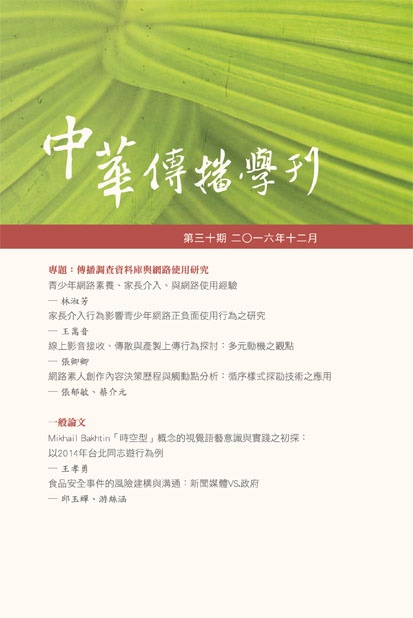 閱覽人數: 2536
閱覽人數: 2536
December
2016
No. 30
傳播調查資料庫與網路使用研究
Taiwan Communication Survey and Research on Internet Use頁數:179 - 220
作者(中)
邱玉蟬、游絲涵
作者(英)
Yu-Chan Chiu & Ssu-Han Yu
關鍵詞(中)
政府新聞稿、風險建構、風險溝通、食品安全、健康風險、新 聞報導 DOI: 10.6195/cjcr.2016.30.06 *
關鍵詞(英)
government press release, risk construction, risk communication, food safety, health risk, news coverage
中文摘要
風險事件發生時,媒體與政府扮演傳遞訊息的重要角色。本研
究以論述分析,探討新聞報導和政府新聞稿如何建構「問題澱粉」與「混充油」事件的風險。研究發現,新聞中專家論述著重長期風險、擅用比喻與舉例;政府論述則著重立即風險,以合法為根基。專家高風險與政府低風險語言,隱含的可能是不同風險評估觀點,與新聞報導與新聞稿在定位與屬性的差異有關。專家高風險與政府「合格與否」語言,可能無助於民眾實質因應食品安全問題。
究以論述分析,探討新聞報導和政府新聞稿如何建構「問題澱粉」與「混充油」事件的風險。研究發現,新聞中專家論述著重長期風險、擅用比喻與舉例;政府論述則著重立即風險,以合法為根基。專家高風險與政府低風險語言,隱含的可能是不同風險評估觀點,與新聞報導與新聞稿在定位與屬性的差異有關。專家高風險與政府「合格與否」語言,可能無助於民眾實質因應食品安全問題。
英文摘要
During food safety crises, news media and governments play key roles in disseminating risk information. By adopting the methodology of discourse analysis, this study examines how four major newspapers in Taiwan and the Taiwan Food and Drug Administration (TFDA) constructed and communicated health risks during two food safety crises involving starch and cooking oil. This study found that experts quoted in news coverage emphasized long-term risks, whereas government officials highlighted immediate risks. In addition, experts used metaphors and provided examples to illustrate the risks, whereas government officials based their risk discourse on laws. These contrasting approaches might be due to the differences in the perspectives on risk assessment or the differences in the nature of news reports and government press releases. When comparing risk discourse in news coverage to the TFDA’s press releases, much common ground can be found; however, this study discovered that the latter included more expressions indicating uncertainty. Experts’ “high risk” language and officials’ legal discourse might not sufficiently assist the public in responding to food safety issues.